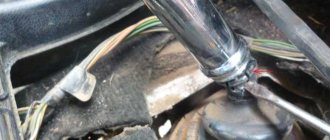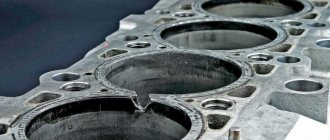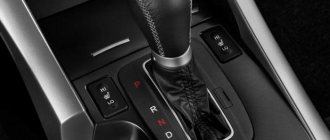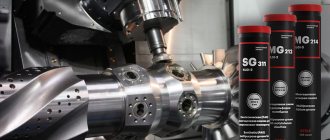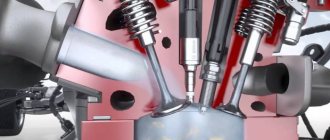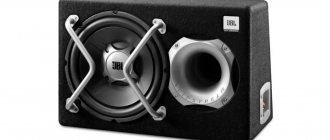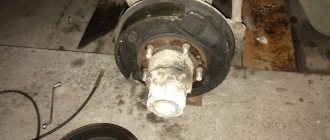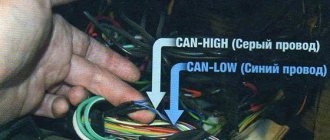Every motorist knows perfectly well that the transmission in a car performs a key function. This is the transmission of torque from the engine. Due to this connection, the wheels rotate and the car moves.
That is, there is a direct relationship between the engine and transmission. But this is not the only consumer that needs power transmission.
There are units and equipment that require their own source to perform their assigned functions. For these purposes, the internal combustion engine itself can be used. Only an additional unit such as a power take-off box, or PTO for short, is used.
Power take-off: purpose and problems
The power take-off (PTO) is an important component of many trucks.
At the same time, there is quite a bit of information on the Internet about its properties and purpose. Let's fill this gap and learn more about COM. The main purpose of the PTO is to select part of the engine torque for its subsequent transmission to various devices mounted on the vehicle chassis. Most often, power take-off is used in agricultural, construction, municipal and other special equipment. The motor energy is transferred using a hydraulic pump or cardan shaft.
PTOs always bear a heavy load, so serious demands are placed on them. They should be compact and lightweight, but at the same time durable. It is important to know that the type of power take-off strictly depends on the type and purpose of the equipment on which it is installed. Any PTO must be fully consistent with the engine and gearbox.
Dependent and independent
There are two main types of PTOs - clutch-dependent and clutch-independent. The former function only when the engine is idling. Dependent boxes are lightweight, easy to install and require almost no maintenance. They are mounted on manual transmissions and activated by the driver using a pneumatic system. If your equipment operates on “mechanics” and does not require power take-off while in motion, a dependent PTO will be the best choice.
An independent power take-off can operate on vehicles equipped with both a manual transmission and an automatic transmission. It is indispensable when you need to transmit torque to special devices while driving (for example, when operating concrete mixer trucks or road cleaning equipment).
Installation options and possible malfunctions
The place where the PTO is “registered” inside the car can be the transfer case, gearbox, engine, or the space between the engine and gearbox. But no matter what design solution is applied, the goals and objectives of the device always remain the same - to efficiently transmit torque to the installed equipment.
The power take-off does a lot of hard work and is made of exceptionally durable parts. However, breakdowns may occur with it. Often they are detected quickly, as the unit immediately begins to behave strangely. In case of malfunctions it can:
• Do not turn on. • Don't turn off. • Release strong jets of compressed air from the pneumatic chamber. • Make a loud, unpleasant noise.
There are many ways to eliminate these problems - from simply tightening the nuts, to completely disassembling the PTO and replacing some parts. In any case, it is not recommended to repair the device yourself without the appropriate knowledge and skills.
If you need a new COM, or repair of an old one, contact us! has been selling and servicing truck units for more than eight years. By contacting us, you can be sure of the quality and price attractiveness of our service.
Power take-offs
The power take-off (PTO) is designed to drive various working parts of equipment installed on a vehicle chassis using a cardan shaft or a hydraulic pump.
The power take-off is a mechanical gearbox, the type and characteristics of which depend on the purpose of the equipment that it drives. In accordance with the amount of additional equipment, one to three power take-offs can be installed on one vehicle.
Power take-offs differ in:
- the number of steps and the value of gear ratios;
- number and relative position of shafts;
- the presence or absence of reverse;
- type of control drive.
Depending on the load on the additional equipment, the power take-offs transmit up to 40% of the maximum power of the power plant. The standards define the main dimensions of the mounting points and gear modules of power take-offs.
Rice. Diagram of a reversible power take-off with a gearbox: 1 - lever for turning on the power take-off; 2 — shift fork rod; 3 — shift fork; 4 — ball retainer; 5 — carriage with a gear wheel; 6 — ball bearing; 7 - driven shaft; 8 — axis of the intermediate gear; 9 — intermediate gear; 10 — gear block axis; 11 — gear block; 12 — driven shaft flange
Power take-off boxes, as a rule, are mounted on the side or end on the gearbox housings or transfer boxes in their upper or lower parts. The driving links of the power take-off box are connected through the hatches of the transmission units to the parts of these units, from which the power is taken off.
Power transmission can be carried out from the gear of the transmission unit to the drive gear of the power take-off. Both gears are in constant mesh with each other, and the power take-off is engaged by a movable carriage that engages the gear teeth in the power take-off box. Power can also be taken from the shaft of the transmission unit. In this case, the power take-off is mounted on the end of the crankcase of the transmission unit, and its drive shaft is located coaxially with the shaft from which power is taken.
The power take-off is switched on by a gear coupling connecting both shafts when there is no load on the box. The power take-off is controlled from the vehicle cabin. The control drive can be mechanical, pneumatic, electro-pneumatic, etc.
The method of lubricating the parts of the power take-off is determined by the location of its attachment to the transmission unit. With side mounting, lubricant is sprayed onto the box parts from the crankcase of the main unit or its own crankcase. When mounted at the top, the design of the power take-off box includes a pump that takes lubricant from the crankcase of the transmission unit and supplies it to the box parts.
Varieties
As you already understand, PTO is used on machines to transfer energy to additional equipment.
Based on the mechanisms being driven and the requirements for the device, there are different types of existing power take-offs. They may differ from each other according to several principles:
- Number of steps. This defines the pitch between the available working mechanisms.
- Presence of reverse. Some components, such as pumps, only rotate in one direction. If this is a truck crane, then the PTO should work in two opposite directions.
- Gear ratio. The change in angular velocity and transmitted torque depends on this value.
- Number of shafts. It may vary depending on the design of the particular box.
- The location of the components that are included in the box.
- Control special signal. It can be mechanical, using a lever or through the on-board computer.
When getting acquainted with the design of power take-off boxes, you should definitely take into account possible options for their location.
Basically, systems can be installed at the following points:
- on the side relative to the vehicle’s gearbox;
- on the end side of the box;
- in the gearbox housing;
- together with the transfer gearbox.
The PTO requires mandatory lubrication, which depends on the installation features and the presence of its own oil reservoir in the design. Most often, lubrication is carried out using oil and the crankcase of the main box.
It also happens that the PTO has an upper location. In this case, a pump is additionally used. It allows lubricant to be supplied to the assembly.
All boxes used on machines can be divided into several subcategories. They are:
- reversible;
- gearless;
- dependent;
- independent.
Each option requires separate consideration for a better understanding of the essence and operating principle of the device.
Reversible power take-off with gearbox and longitudinal shaft arrangement
A reversible power take-off with a gearbox and a longitudinal shaft arrangement is installed on the lower side of the gearbox housing. Power is taken from the gearbox intermediate shaft gear, with which one of the gears of block 11 is constantly engaged. The other gear of this block is in mesh with the intermediate gear. The gear block and intermediate gear 9 are mounted on axles fixed to the crankcase.
The driven shaft 7 of the power take-off rotates on two ball bearings 6. The carriage 5 with a gear wheel moves along the splines of this shaft using a shift fork. The shift fork 3 is mounted on a movable rod 2 connected to the power take-off lever 1 installed in the vehicle cabin. The lever has three fixed positions. The rod is fixed using a ball retainer 4 with a spring. In the right position of the rod, the carriage with the gear is meshed with the intermediate gear, which ensures forward transmission. In the left position of the rod, the gear is engaged with the larger gear of block 11, which ensures reverse transmission. In the middle position of the rod, the power take-off is turned off and the driven shaft does not rotate. At the end of the driven shaft there is a flange 12 for attaching the drive shaft of additional equipment.
Rice. Power take-off without gearbox: 1 - transfer case input shaft; 2 — power take-off shaft; 3 - carriage; 4 — power plug; 5 - retainer with spring; 6 — power fork rod; 7 - flange; 8 - eccentric; 9 - plunger; 10 - discharge valve; 11 - check valve; 12 - suction valve; 13 — power take-off cover; 14 - oil supply line to the pump
Power take-off without gearbox
In addition to the considered power take-off with a gearbox, boxes without a gearbox that are simpler in design are also used, providing one stage with a gear ratio of 1.0. Power is taken from the input shaft 7 of the transfer case, which has splines at the end. The power take-off is attached to the end of the transfer case housing in its upper part. Shaft 2 of the power take-off at one end has the same splines as shaft 7, and on its other end a flange 7 is installed for mounting the drive shaft of additional equipment. The power take-off is switched on by blocking shafts 1 and 2 using carriage 3. The carriage is moved by the power take-off fork 4, mounted on a rod that has two fixed positions: in the left position of the rod, the power take-off is on, and in the right position it is off. The direction of rotation of the power take-off shaft is changed when the 3rd gear in the gearbox is engaged.
It will be useful: How to warm up the variator in winter: what you need to know
A design feature of this power take-off is the presence of a plunger pump, which serves to lubricate the parts of the power take-off and transfer case of a stationary vehicle when additional equipment is running. The pump is located in a housing installed in the boss of the power take-off box cover 13, and consists of a discharge plunger 10, a suction valve 12 and a return valve 11. The pump is driven by an eccentric located on the power take-off shaft. Oil enters the pump via line 14 from the transfer case housing and is supplied under pressure to the parts of the power take-off box and the transfer case input shaft.
This box is controlled by a lever connected to rod 6 and installed in the vehicle cabin.
Gearless mechanisms
In addition to the geared PTOs that were discussed above, there are also gearless gearboxes designed for power take-off. Their distinctive feature is the simplicity of their design. They also have a single gear ratio.
To select the required power in this case, a transfer case input shaft is used, at the end of which special splines are provided. These types of boxes are mounted on the end part of the transfer case housing in the upper part of the structure.
The PTO shaft at one end has similar splines as the transfer case primary shaft. At the other end, a flange is installed to secure the drive shaft of additional automotive equipment.
To turn on the selection box, you need to lock the two shafts using a special carriage. The latter moves due to the power fork located on the rod. The rod has two fixed standard positions. If this is the left position, then the selection box is in active, that is, working condition. The right position means that the PTO is off.
You can change the direction of rotation of the PTO shaft by engaging reverse gear at the vehicle's gearbox.
If you study the design of the box in question, you will notice one important nuance. This is the use of a plunger pump. It is needed to lubricate the components of the PTO housing and transfer case at a time when the car is stationary, but additional equipment is working. This prevents possible wear of parts due to lack of lubrication. The pump forcibly supplies oil to the components, thereby lubricating and cooling them.
The plunger-type pump itself is installed in a housing located directly in the boss of the PTO cover. It includes the plunger pump itself, as well as a non-return, suction and mandatory discharge valve.
To control such a selection box, a lever is used, directly connected to the rod and located in the cabin of the machine or other vehicle.
The operation of power take-offs without a gearbox has been sorted out. Now it’s worth looking at 2 more types of knots.
Diagrams of power take-offs of various cars
Rice. Diagram of the MAZ 5334 AC-8 power take-off: 1 - rubber diaphragm; 2 - spring; 3 - rod; 4 — body; 5 — shift fork; 6 - cuff; 7 - splined shaft; 8 - flange; 9 — pin; 10 - gear; 11 - idler gear; 12 — tachometer primary converter; a - camera
Rice. Diagram of the KSM-68B power take-off: 1 - gear shift rod; 2 - body; 3 — gear shift lever; 4 — PTO power fork; 5 — gear (Z = 17); 6, 7, 10, 20 — bearing; 8 - coupling; 9 — secondary shaft; 11 - cover; 12 — oil seal; 13 - flange coupling; 14 — handle; 15 — gear shift fork; 16 — gear (Z = 41); 17 — roller bearing; 18 — PTO switch rod; 19 — gear axis; 21 — primary shaft; 22 — gearbox input shaft gear; I - lateral clearance in engagement
Rice. Power take-off box of the CMK-10 crane (a) and its kinematic diagram (b): 1, 5 - flanges, 2 - bearing; 3, 4 - input and output shafts; 6 — body; 7 - crown; 8 — shift clutch; 9 — ring gear; 10 - hub; 11 - pulley; 12 - fingers
Rice. Power take-off RK-5: 1 — gear block PK-5-11A; 2 - axis RK-5-13; 3 — box body PK-5-01; 4 — pump NSh10; 5 — pump shaft RK-5-16B; 6 — plug RK-5-26A; 7 — switching roller RK-5-21; 8 — shift roller RK-5-26; 9 — plug RK-5-27A; 10 — gear RK-5-14A; 11 — selection shaft RK-5-31A; 12 — gear RK-5-15A
Rice. Power take-off ZIL-131: 1 — gear fork rod; 2 and 23 - cuffs: 3 - o-ring; 4 — power plug; 5 — ball retainer; 6 — rod plug; 7 — rear bearing cover; 8 — ball bearing; 9 — gear wheel; 10 - main shaft; 11 — axis of the constant-mesh gear; 12 — support washer; 13 — intermediate gear wheel of constant mesh; 14 — axis of the gear block; 15 — gearbox housing; 16 — gear block; 17 — roller bearing; 18 — support washer; 19 — spacer ring; 20 — bearing cover gasket; 21 — front bearing cover; 22 - flange; 24 — flange support washer; 25 - filler plug; 26 — power take-off lever; 27 — drain plug; 28 - nut; 29 — lock nut; 30 — lever bracket; 31 - gasket
Rice. MAZ power take-off: 1 — intermediate gear; 2 - body; 3 — driven gear; 4 - fork; 5 — locking bolt; 6 — lock washer; 7 - axis; 8 — ball bearing; 9 — roller bearing; 10, 14 — covers; 11 - glass; 12 - spring; 15 - nut; 15 — pneumatic chamber; 16 - diaphragm; 17 — washer; 18 — thrust washer; 19, 23, 25 — gaskets; 20 - screw; 21 — sealing ring; 22 — rod; 24 - shaft
Rice. Power take-off from the transfer case (KOM-1) (for special equipment): 1 - crankcase; 2 - spacer sleeve; 3 and 20 - nuts; 4 and 18 — bearing caps; 5 - shaft; 6 and 23 - ball bearings; 7 — carriage; 8 - plug; 9 — hatch cover; 10 — shield; 11 - switch; 12 — switching chamber; 13 - membrane; 14 - spring; 15 — rod; 16 - gasket; 17 — adjusting washer; 19 - flange; 21 — spring washer; 22 and 28 — support washers; 24 — retaining ring; 25 — toothed ring of constant engagement; 26 - plug; 27 - axis; 29 — roller bearing; 30 - spacer ring; 31 — forks; 32 - protect the valve; 33 — lock bolt; 34 - locking plate
Rice. Electrical diagram of the power take-off: 1 - switch for the power take-off warning lamp; 2 — air valve solenoid; 3 - three-terminal connecting panel; 4 - power take-off relay; 5 — front axle activation relay; 6 - two-socket connector; 7 - switch; 8 — control lamp for turning on the power take-off; 9 - 20 A fuse
Types of power take-offs
We are looking for two authors for our site who are VERY well versed in the structure of modern cars.
Contact by mail
The main purpose of a car transmission is to transfer force from the engine to the drive wheels with minimal losses. Some machines have mechanisms that require a source of energy to perform their assigned functions. It is irrational to install an additional internal combustion engine or electric motor, so the main engine of the car is used as a drive. To direct the power flow from the main kinematic circuit, a power take-off is used. From one to three similar mechanisms can be installed on vehicles.
Examples of PTO installation locations
The additional power take-off box serves to transfer energy to equipment installed on the vehicle. Depending on the type of driven mechanisms and the requirements for the device, the characteristics of the KDOM may differ:
- by the number of steps that determine the step between operating modes;
- the possibility of providing the reverse required for the mechanism, for example, the pump requires rotation only in one direction, and the power take-off of a truck crane must be capable of operating in both directions;
- the value of gear ratios that provide a change in angular velocity and transmitted torque;
- the number of shafts structurally included in the PTO;
- the location of the components included in the power take-off device;
- a control signal, which can be purely mechanical, made using a lever, or issued by the car’s on-board computer.
According to the installation location, there are PTOs that are mounted:
- on the side of the gearbox;
- from the end of the gearbox;
- in the gearshift device housing;
- in conjunction with the distribution.
Appearance of the COM
The method of lubricating the power take-off gears depends on the method of its installation and the presence of its own oil container. Typically, oil from the crankcase of the main unit is used. When the mechanism is located at the top, a pump is used to supply lubricant to the PTO.
What it is
First you need to understand the purpose of power take-offs and understand why they are used in the design of a car or other vehicle.
An example of transmission and engine forces, which are transmitted to the drive wheels with minimal losses, was given for a reason. There are mechanisms and components on a car that need their own energy source in order to be able to perform their assigned functions.
This largely makes it clear why that same power take-off is needed and for what purposes it is intended. After all, putting another motor or electric motor under the hood makes no sense. The drive is the main internal combustion engine of the vehicle itself.
This is what the so-called power take-off is for. It allows you to connect the motor with additional consumers and transmit power flows from the main kinematic circuit. Depending on the specific type of transport, it may have from one to several such mechanisms.
KOM can be described as a classic mechanical gearbox. But its type and technical characteristics largely depend on what equipment is used to work with it.
Depending on the load provided for additional and attachments, the box can transmit up to 40% of the maximum power parameters of the internal combustion engine. As a result, the assembly in the form of a selection box intended for the implementation of such tasks is structurally different.
There are also regulated standards for where the power take-off is installed and how it is located.
Reversible box
The PTO shown in the figure below is designed for installation in the side of the gearbox housing. The useful power is taken from the intermediate shaft of the gearbox. The gears are in continuous mesh.
Reversible box
It will be useful: Which sealant is better for a car engine?
The control lever has 3 fixed positions for selecting the operating mode of the power take-off. In the right position, direct transmission is carried out. In this case, the carriage with a gear wheel is constantly in engagement with the intermediate shaft of the gearbox. When moved to the extreme left position, reverse is activated. To ensure reverse motion, the gear wheel is connected to a gear installed inside the PTO gearbox. When moving to the middle position, the driven shaft stops rotating and the additional power take-off box goes into the off position.
Power take-off without gearbox
The main difference between gearless PTOs is their simplicity of design and single gear ratio. The image below shows the Ural power take-off, designed to drive a winch. It is mounted to the end of the transfer case, allowing it to receive torque from the input shaft through a movable coupling. Power take-off occurs from the input shaft.
PTO without gearbox
The mechanism is controlled using a special fork. The power take-off is activated by blocking the transfer case input shaft and PTO using a carriage. The lever has two fixed positions. The left one corresponds to power transmission, and the right one corresponds to the off state. The PTO does not provide reverse. To engage the reverse direction, you need to select reverse gear using the gearbox selector.
The parts are lubricated by a plunger pump. This allows the attachment to be used on a stationary vehicle. The pump is located in a special boss of the PTO cover. It also helps lubricate the transfer case.
Dependent type PTO
Clutch-dependent gearboxes are installed on vehicles with manual transmission. This mechanism is installed if there is no need to turn on attachments on the go. For example, the power take-off box of a dump truck is often made in a dependent design.
The main advantages that KZOM has:
- light weight;
- ease of repair of power take-offs;
- no load on the engine when the PTO is off;
- simplicity and reliability of the design, allowing you to confidently operate both new and repaired boxes, which is confirmed by an extensive sample;
- low maintenance requirements;
- increased safety, since the drive cannot be activated while moving, which is especially important for a dump truck PTO.
Installation of the dependent type of boxes is quite simple. Installation is carried out in a specially designated place, after removing the special hatch. When positioned at the top, a pump is used. If necessary, dismantling the KZOM does not cause difficulties and does not affect the performance of the main power transmission.
Common PTO malfunctions
The power take-off, like any other unit of a special vehicle, will work long and reliably only if the recommendations for its operation are followed. In particular, with regular and timely maintenance. This is especially important for the PTO mechanism, because its parts are subject to wear and tear.
Proper operation of the box is also critical. This unit must be turned on according to the recommendations specifically for this model (for example, only with the clutch depressed and the car stopped).
Reliable fixation of the device during installation is also important, because otherwise, increased vibration will occur, which negatively affects its operation.
During repair of the PTO, it is recommended to examine the driven gear for the possibility of its further operation. If it is in unsatisfactory condition, and the mechanic does not pay attention to this, then this negligence will cause increased wear on the drive gear.
The malfunctions that happen from time to time with the PTO are different. Some can be determined independently and eliminated without taking the car to a service center. These include:
- Increased noise. A possible cause is improper gear engagement.
- The node does not turn on. A stream of air breaks through. It is necessary to check the integrity of the diaphragm in the pneumatic control chamber.
- The mechanism does not turn off completely. The return spring may have broken.
- There is leakage of working fluid on the flanges. The breather is dirty or the seals are worn out.
For most other problems, you need to contact qualified technicians who have special equipment for diagnosis and repair.
Independent power take-off design
Installation of an independent type PTO is possible on a vehicle with any type of transmission. The main advantage is the ability to turn on the mechanism both when the vehicle is stationary and on the move. An example of a device is a KAMAZ power take-off. Placement is possible both to the right and left side hatch of the gearbox, as well as from the rear end and depends on the model of the gearbox. A pump is used for lubrication.
The speed of rotation of the gearbox shafts and the transmitted power can be controlled directly using the engine. Switching the PTO on and off is often accomplished using electropneumatics and hydraulics. This type of gearbox is widespread on cars with automatic transmission.
Dependent boxes
Here we are talking about clutch dependence. Such devices are usually located on vehicles equipped with manual transmissions. Such systems are relevant to use in cases where attachments do not need to be turned on on the go, that is, while the vehicle is moving.
Dependent boxes have several main advantages:
- they are light in weight, which simplifies working with them during repair and maintenance;
- the repair itself does not cause any difficulties if you have a certain level of knowledge;
- if the box is in the off state, such PTOs do not additionally load the engine;
- the design is quite simple and reliable;
- they have a long service life;
- maintenance requirements are minimal;
- high level of safety, since the selection box cannot spontaneously start working while on the move.
The most striking example of machines that use dependent power take-offs are dump trucks.
Installing dependent boxes is extremely simple. A specially designated place is provided for this. The hatch is first dismantled. If the location is top, a pump is additionally used in the circuit.
Dismantling work is also simple. If the main gearbox is removed, this will not affect the operation in any way.
Review of power take-off using the example of KOM-68B
KOM-68B is a single-stage mechanism. Its body is cast from cast iron. The box is installed instead of the gearbox cover. Gears are lubricated by spraying oil poured into the gearbox.
Serves KOM-68B to drive the pump of fire trucks. Torque transmission is possible both when parking and when moving the car in first or second gear. This allows the pump to be used on vehicles equipped with a fire monitor.
To ensure coordination of the speeds of the crankshaft and the centrifugal wheel, it is possible to use an intermediate gearbox. It is located between the drive shaft and the fire pump. The intermediate wheel is responsible for maintaining the direction of rotation in the gearbox. To facilitate the design, the shafts can be made hollow.
KOM-68B
Existing power take-offs have significantly expanded the functionality of vehicles. Thanks to the redirection of part of the energy, there is no need to install additional drive units. This simplifies the design of the car, reduces the number of components and increases the reliability of the car as a whole.
Power take-off
The vehicle's transmission is designed to transmit power flow from the engine to the drive wheels, changing the magnitude and direction of torque if necessary. But sometimes the transmission is also assigned additional functions - to direct part of the power flow received from the engine to drive auxiliary equipment that is not directly related to the movement of the car or other vehicle. Most often, such equipment includes winches for off-road vehicles or lifting equipment for dump trucks, as well as other similar devices, machines and mechanisms that require an energy source for operation. They receive this energy from the car engine through a special device - the power take-off (PTO).
The power take-off is a manual gearbox, the type and characteristics of which depend on the purpose of the accessories being driven. Depending on the amount of additional equipment, one to three power take-offs can be installed on one vehicle.
Power take-offs differ:
- by the number of steps;
- by the value of gear ratios;
- by the number and relative position of the shafts;
- by the presence or absence of reverse;
- by type of control drive.
Depending on the load on the additional equipment, the power take-offs transmit up to 40% of the maximum power of the power plant. The standards define the main dimensions of the mounting points and gear modules of power take-offs.
Power take-offs are typically mounted on the side or end of the transmission or transfer case housing. The driving links of the power take-off box are connected through the hatches of the transmission units to the parts of these units, from which the power is taken off.
Power transmission is most often carried out from the gear of the transmission unit (gearbox or transfer case) to the drive gear of the power take-off. Both gears are in constant mesh with each other, and the power take-off is engaged by a movable carriage that engages the gear teeth in the power take-off box.
Power can also be taken from the shaft of the transmission unit. In this case, the power take-off is mounted on the end of the crankcase of the transmission unit, and its drive shaft is located coaxially with the shaft from which power is taken. In this case, the power take-off is switched on by a gear coupling connecting both shafts when there is no load on the box.
The power take-off is controlled from the vehicle's cabin. The control drive can be mechanical, pneumatic, electro-pneumatic, etc.
The method of lubricating the parts of the power take-off is determined by the location of its attachment to the transmission unit. With side mounting, lubricant is sprayed onto the box parts from the crankcase of the main unit or its own crankcase. With the top mounting, the design of the power take-off includes a pump that takes lubricant from the crankcase of the transmission unit and supplies it to the parts of the power take-off.
Reversible power take-off
A reversible power take-off with a gearbox (Fig. 1) and a longitudinal shaft arrangement is installed on the lower side of the gearbox housing. Power is taken from the gearbox intermediate shaft gear, which is in constant mesh with one of the gears of block 11. The other gear of this block is in mesh with the intermediate gear. The gear block and intermediate gear 9 are installed on axles mounted on the power take-off housing.
It will be useful: Kia Sorento diesel check light is on
The driven shaft 7 of the power take-off rotates on two ball bearings 6. The carriage 5 with a gear wheel moves along the splines of this shaft using a shift fork. The shift fork 3 is mounted on a movable rod 2 connected to the power take-off lever 1 installed in the vehicle cabin. The lever has three fixed positions. The rod is fixed using a ball retainer 4 with a spring.
In the right position of the rod, the carriage with the gear is meshed with the intermediate gear, which ensures forward transmission. In the left position of the rod, the gear is engaged with the larger gear of block 11, which ensures reverse transmission. In the middle position of the rod, the power take-off is turned off and the driven shaft does not rotate. At the end of the driven shaft there is a flange 12 for attaching the drive shaft of additional equipment.
Power take-off without gearbox
In addition to the considered power take-off with a gearbox, boxes without a gearbox that are simpler in design are also used, providing one stage with a gear ratio equal to one (Fig. 2).
Power is taken from the transfer case input shaft 1, which has splines at the end. The power take-off is attached to the end of the transfer case housing in its upper part. Shaft 2 of the power take-off at one end has the same splines as shaft 1, and on its other end a flange 7 is installed for mounting the drive shaft of additional equipment.
The power take-off is turned on by blocking shafts 1 and 2 using carriage 3. The carriage is moved by a power take-off fork 4, mounted on a rod that has two fixed positions: in the left position of the rod, the power take-off is on, and in the right position it is off. The direction of rotation of the power take-off shaft is changed when reverse gear is engaged in the gearbox.
A design feature of this power take-off is the presence of a plunger pump, which serves to lubricate the parts of the power take-off and transfer case of a stationary vehicle when additional equipment is running. The pump is located in a housing installed in the boss of the cover 13 of the power take-off, and consists of a plunger 9, a discharge valve 10, a suction valve 12 and a check valve 11. The pump is driven by an eccentric located on the power take-off shaft.
Oil enters the pump via line 14 from the transfer case housing and is supplied under pressure to the parts of the power take-off box and the transfer case input shaft.
Such a power take-off is controlled by a lever connected to a rod 6 and installed in the cabin of the car or vehicle.
What is a power take-off in a car?
As you know, the result of engine operation is the creation of torque on the crankshaft, after which the torque is transmitted through the gearbox to the drive wheels. Also, various schemes and solutions can be used in the design of the transmission itself (mono-wheel drive, all-wheel drive, transfer case, etc.).
If we talk about special equipment, you can also quite often hear about an element that is known as PTO (power take-off). In this article we will look at what a power take-off is, as well as why a PTO is needed in various vehicles.
Tips and tricks
Manufacturers separately provide increased wear resistance by making PTO parts from reinforced materials.
However, given the fact that power take-offs, regardless of type, experience serious loads, it is important to follow certain rules and recommendations during their operation
First of all, wear of the main (large) PTO gear is often due to the unsatisfactory condition of the gearbox mating gear
When replacing the power take-off or during its repair, it is important to troubleshoot the gearbox output gear in advance. When installing the power take-off, you must separately make sure that the fastenings are secure.
The fact is that poor-quality fastening or errors when installing the PTO lead to strong vibration of parts, which quickly and intensively destroys the device
When installing the power take-off, you must separately ensure that the fastenings are secure. The fact is that poor-quality fastening or errors when installing the PTO lead to strong vibration of parts, which quickly and intensively destroys the device.
It is also important to turn on the power take-off itself correctly and in the exact sequence. Switching on should be carried out taking into account the requirements and recommendations for a particular type of unit (for example, if switching on in motion is not allowed, switching on the PTO to implement power take-off on the box is possible only on a stationary machine, etc.). Finally, we note that that you need to periodically check the reliability of the power take-off box fastenings, as well as monitor the quality of the lubrication, perform additional oil lubrication of individual elements, which will improve the quality of work and increase the overall service life of this device
Finally, we note that you need to periodically check the reliability of the power take-off box fastenings, as well as monitor the quality of the lubrication, perform additional oil lubrication of individual elements, which will improve the quality of work and increase the overall service life of this device.
Power take-off: purpose, types, design and principle of operation
So, let’s immediately note that the power take-off box or PTO (unlike additional boxes, transfer cases or dividers) is not a mandatory device in the design of the gearbox, chassis and other components of the car.
It turns out that the PTO does not affect the driving performance of the vehicle in any way and does not participate in the processes of transferring power from the internal combustion engine to the wheels of the car. In other words, it is not literally part of the vehicle's transmission.
In this case, the main task of this box is to take power from the engine in order to enable the operation of other additional equipment. Simply put, the PTO transmits the torque of the internal combustion engine to the accessory drive.
Otherwise, the PTO is a separate unit that transmits torque from the motor to various devices (pumps, winches, compressors, etc.). The box can take up to 40% of the power of the internal combustion engine. In this case, the operating principle of the power take-off is always the same.
The only thing is that the node can be placed in different places. For example, the power take-off box on the KamAZ 4310 is located on the transfer case (transfer case), while in other versions the PTO is placed on the vehicle’s gearbox itself.
Also, taking into account the presence of a particular set of equipment, the machine may have 2 or even 3 power take-offs of different types.
The boxes themselves differ from each other:
- by the number of steps and gear ratio;
- by the number of shafts and their location;
- by the presence or absence of reverse (rotation both forward and backward);
- by type of PTO control drive;
It should also be noted that boxes of this type are available both with and without a gearbox. As for the design of the power take-off itself, this unit can be roughly compared with the design of a conventional manual transmission on cars.
COMs are also divided into dependent and independent. The former are actually integrated into the gearbox, have less weight, and do not consume excess power, but there are also disadvantages. First of all, such a box can only be turned on when the car’s clutch is disengaged. It is also prohibited to turn on the dependent PTO while the vehicle is moving.
An independent power take-off can be installed on vehicles with any type of internal combustion engine and gearbox, and they can also be operated without disengaging the clutch (both on stationary vehicles and in motion). Also, the power take-off activation system can be either mechanical or electro-pneumatic, or hydraulic.
The air compresses the return spring with the diaphragm, which leads to the movement of the rod with the fork for engaging the driven gear. This is how the driven and intermediate gears of the power take-off engage. After the air is released from the pneumatic chamber, the rod will return to its initial position, that is, the driven gear will disengage and will not rotate further.
Operating procedure of the COM
Fundamentally, the COM is similar to a gearbox, only much simpler. It contains a drive shaft with a rigidly fixed gear. When turned on, it meshes with a driven gear mounted on another shaft (actually a PTO), which transmits rotational torque to the working equipment.
If the box is mechanically controlled, the rod is moved using a lever. If there is a pneumoelectric system, the unit must have a chamber into which air is supplied under pressure. The latter acts on the diaphragm connected to the spring, after which it is compressed, moving the rod with the operating fork. The gears engage. After bleeding the air, the spring straightens, the rod moves in the opposite direction, and the gears are separated.
The PTO is capable of “taking away” up to 40% of the engine power. Most models turn on while the car is stationary. Although, there are also those (for example, on municipal vehicles) that also work when the unit is moving.
